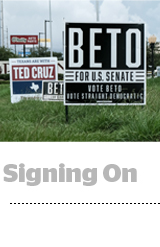 Online spending records have shattered across the country during this year’s midterm election cycle, but no campaign has brought more attention to digital media than that of Democrat Beto O’Rourke, a Texas congressman running for Republican Ted Cruz’s Senate seat.
Online spending records have shattered across the country during this year’s midterm election cycle, but no campaign has brought more attention to digital media than that of Democrat Beto O’Rourke, a Texas congressman running for Republican Ted Cruz’s Senate seat.
No candidate this year has raised more money online or spent more on Google, Facebook or Twitter than O’Rourke, according to online political advertising reports from New York University researchers and from those large consumer platforms.
The search and social spending brings exposure and earned media attention – in the same way political TV ads generate news coverage. But win or lose, Beto for Senate will be the most scrutinized Democratic campaign this year as other Democrats across the country are digitally outspent by Republicans.
The Beto playbook
The O’Rourke campaign has spent $5.4 million on Facebook and Instagram, $763,000 on Twitter and $1.3 million with Google since May, according to political ad transparency products all three platforms launched this year.
On Facebook, the O’Rourke team has embraced the practice of creating many ads with small variations. It allocates few dollars to each creative execution, ranging from around $100 to the low thousands of dollars. O’Rourke has 710 active ads on Facebook, for instance, compared 18 spots running for the Cruz campaign.
Another key to O’Rourke’s social strategy is revealed in the split between ads running in Texas and ads with national reach and higher spend levels that form the backbone of his record-breaking fundraising effort.
O’Rourke’s social media ads typically include a prompt such as a “donate” button or, if the recipient is in Texas, a link to voter registration information, an email submission to commit to vote or an RSVP for upcoming campaign events.
The more things change
The Texas race is in some ways a microcosm of the state of play online between Democrats and Republicans.
O’Rourke has far outpaced Cruz in direct donations, exceeding a one-week online fundraising goal of $5 million before a Federal Election Commission reporting deadline at the end of September. The Cruz campaign, meanwhile, set a $100,000 online goal for the same period [[pics from archive]]. But Cruz and conservative candidates across the country are buoyed by a massive tide of outside spending.
Of the 11 political advertisers that have spent more than $1 million on Google in the past six months, the only spenders on the left are the O’Rourke campaign and Priorities USA, the largest Democratic super PAC. The top seven advertisers are all Republican advocacy groups, including big Cruz backers like the Senate Leadership Fund and the National Republican Senatorial Committee.
The O’Rourke campaign has championed digital media for fundraising and direct-response goals but spends the lion’s share of its “persuasion” budgets on television.
O’Rourke leads all political spenders online, but the campaign is putting its fresh $5 million from digital fundraising to work on the Texas airwaves to maintain his TV advantage in the state. This is true of many Democractic campaigns nationwide.
“Many Dems have gone backward this cycle in the belief that digital is strong for persuasion,” said Keegan Goudiss, managing partner at Revolution Messaging, a liberal ad tech vendor that has worked with the O’Rourke campaign. “A lot of practitioners in Democratic politics believe you can’t have the same emotional reaction with a digital video ad as you can with a traditional TV ad.”
Why Dems are banking on Beto
Aside from the pure partisan desire to win a statewide race in deep red Texas, liberal digital media buyers and operatives hope the O’Rourke campaign will blaze a trail for online advertising that other Democratic candidates can follow.
Democratic candidates in conservative states, for instance, might adopt the tactic of broad, always-on social media fundraising in California, New York, Washington and other states with big liberal cities while running microtargeted ads and voter registration drives in their home states.
Democrats lag Republicans in social and programmatic as big-spending conservative advocacy groups set digital minimums of as much as 40% when they send money to campaigns. Even if other liberal candidates don’t pick up the precise O’Rourke playbook, the campaign offers a needed blueprint for the party’s digital strategy going forward.
“It’s a little frustrating even with Beto because you don’t want digital to be only thought of as a DR channel for fundraising and email list-building,” and TV is still seen as the persuasion channel, said one Democratic digital media operative. “But we need the people running campaigns to open their eyes to the online opportunity that’s being squandered right now.”
This post was syndicated from Ad Exchanger.


More Stories
Who will be the AUNZ Agency Of The Year?
Finally, the Ad Industry Can Deliver on Purpose-Driven Media Investment
FEDERATION announces its first CSO